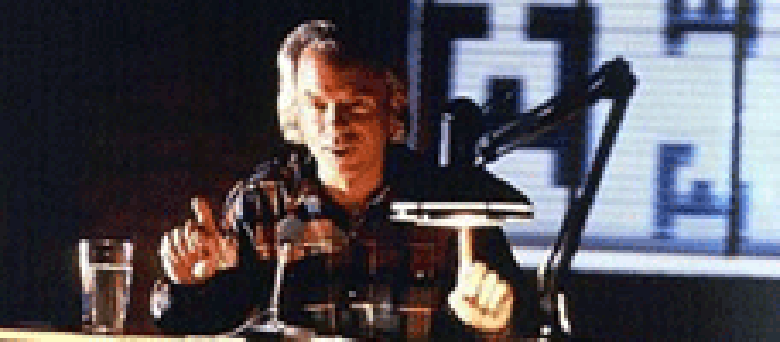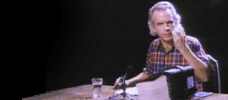Reviews
Steven Soderbergh
USA, 1996
Credits
Review by Teddy Blanks
Posted on 06 April 2008
Source Fox Lorber VHS
Related articles
Reviews Swimming to Cambodia
Reviews Monster in a Box
Categories Spalding Gray: Monologues on Film
Spalding Gray is conspicuously absent from the first ten minutes of Gray’s Anatomy, making clear from the start that it is a radical departure from his previous monologue movies. Instead we are shaken with a series of stories from folks who have suffered from extreme eye conditions. This black and white footage is in high contrast, resembling night-vision, and has the strange effect of obscuring our view of the subjects’ eyes. We hear from a man whose eye was once caught in a fishing hook, and the woman who mistook a bottle of superglue for eye-drops. We keep expecting one of these stories to end with blindness.
When color returns, and Gray takes over - his turn to tell an eye story - it’s a shock to see him on a constructed movie set. His desk, microphone, and water glass aren’t on a stage; they are in the middle of a room with brick walls and windows with blinds. There is no audience as there was in Swimming to Cambodia and Monster in a Box. His voice is deep and crisp, free of the hum and murmur of live performance, resonant with the precision of a recording studio. Gray’s journey, this time around, isn’t on an exotic film shoot, through America’s foreign policy or in a draining existence in Hollywood. He turns his gaze quite literally inward as he walks us through the myriad alternative remedies he seeks in avoidance of an operation to reduce the damage caused by his macular pucker, a condition that has him seeing out his left eye as though he were looking through “the bottom of a coke bottle.”
The prospect of the surgery, which he objects to in name mostly (it’s called “macular scraping”), has him scared stiff. He falls into a deep depression, and will try anything - anything - if it means dodging legitimate medical care. He was raised a Christian Scientist, so flocks to a Christian Science Practitioner. (He then remembers why he stopped being a Christian Scientist.) He follows a sorcerer’s apprentice named Azaria Thornberry, whose energy he sees as floating pink balls of cotton candy, to a Native American sweat lodge. He pays a visit to a kooky old ‘nutritional opthamologist’ who puts him on a strict raw vegetable diet. And most radically, he flies to the Philippines to see a psychic surgeon, seemingly aware that a psychic surgeon is nothing more than a bloody sleight of hand artist. After this fails, he finally decides to get the operation.
The film jumps to more black and white interviews, and instead of eye accident victims, we are faced with a few people who have just seen this monologue (and Spalding Gray, apparently) for the first time. One of them is a doctor with a southern accent, who says, “I certainly would advise him, some of these alternative therapies he should not do … this condition has a pretty good prognosis.” This is a droll remark, and despite having obviously missed the point of the monologue, the doctor brings up an interesting question. If Gray knew the relative safety of the surgery, why did he go through all of these methods? Throughout his story, Gray takes a skeptical, mocking tone when referring to the very New Age healing techniques he is attempting to rely on. We know he is neurotic, so we buy that he is desperate, but he takes a few steps past desperation. It becomes clear (and Gray not-so-vaguely hints at this a number of times) that he put himself through much of this healing quest in order to obtain more personal information to include in Gray’s Anatomy.
While not exactly a revelation, his veracious life-imitates-art, art-imitates-life postmodern admission marks a shift from his previous work. If a great storyteller’s art is in his performance, his research is in the accumulation of experience. He is no longer just telling us his stories; he is letting us in on his behind-the-scenes process of story gathering. This self-referential stewing is reflected in the choices director Steven Soderbergh makes in visualizing Gray’s words.
Soderbergh seems to understand, as Jonathan Demme did with Swimming to Cambodia, that translating a Spalding Gray monologue into an equally convincing movie is a unique task that requires an explicit aesthetic plan. Demme’s was to interject as little as possible, and make us feel a part of an audience in a compact performance space in Soho. The visual content of that film was deliberately reduced to Gray’s movement and expression. He let the actions described in the monologue play out like a movie in our minds. Soderbergh’s approach, surely taking Demme’s into account, is completely different, but just as brilliant. He puts Gray in a surreal, interpretive visual world. There are drastic changes in lighting and camera angles. He shoots through blinds, wheels Gray through various projected backgrounds (eye charts, clouds, forests) and abstractions, and creates settings that match and enhance the content and mood of the performance.
Soderbergh’s extensive art direction and deconstruction has a few key consequences. When Gray’s monologues are filmed from the stage, they retain, more or less, their original structure, seeming like an endless stream-of-consciousness rant. With Anatomy, Soderbergh necessarily has him break up his speech into discernible scenes, so that he will often stop talking and just sit there, as we hear his voice from the next scene bleeding into the shot before it jumps to him, at his desk, in a different location. This clearly affects Gray’s acting. He is more subdued, and has to learn to get himself worked up and wind down incrementally, to build momentum without doing it all at once. It’s nice to have him in bite-size pieces like this; he is easier to digest. The other consequence of Soderbergh’s method is that Gray’s chair and table and microphone, while certainly a trademark before, are elevated to iconic status. Spalding Gray, seated, becomes an indelible image as he moves around, silhouetted and blurred against several backgrounds and environments.
In his rumination of medical problems, Gray returns to a subject he touches upon in many of his monologues: his mother’s suicide. He talks about a theory he’s heard - he loves theories - called the “Bermuda Triangle of Health.” During the ages 50, 51, and 52, he says, we all start falling apart. Some people don’t survive, and some people make it through and live long, healthy lives. His mother died during her “Bermuda Triangle.” Spalding made it through safely, but seven years after the release of this film, and three years after being injured severely in a car crash, he would go on to suffer his mother’s fate. Knowing this now sheds a somber light on this film, which was the last of his monologues to be made into a movie. He hasn’t lost any of his humor or energy, but Gray’s Anatomy looms heavy with the knowledge that this peculiar medical tale is the last time we’ll get to see him tell a story on the big screen.
More Spalding Gray: Monologues on Film
We don’t do comments anymore, but you may contact us here or find us on Twitter or Facebook.






